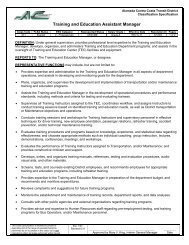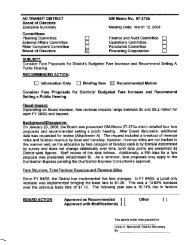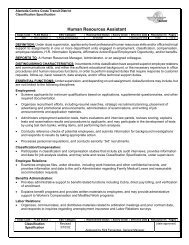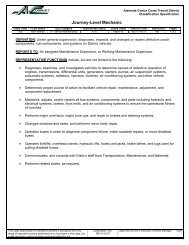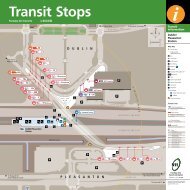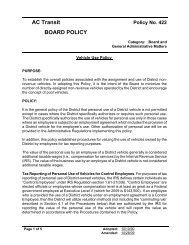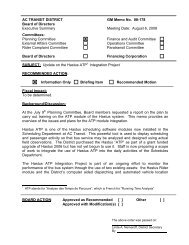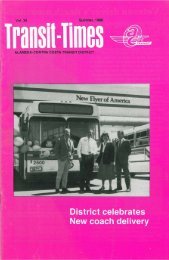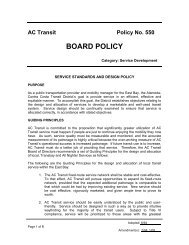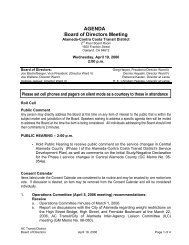AC TRANSIT DISTRICT GM Memo No. 06-228 Board of Directors ...
AC TRANSIT DISTRICT GM Memo No. 06-228 Board of Directors ...
AC TRANSIT DISTRICT GM Memo No. 06-228 Board of Directors ...
Create successful ePaper yourself
Turn your PDF publications into a flip-book with our unique Google optimized e-Paper software.
<strong>GM</strong> <strong>Memo</strong> <strong>No</strong>. <strong>06</strong>-<strong>228</strong><br />
Subject: Proposed Outline <strong>of</strong> Revised Policy 550<br />
Date: October 4, 20<strong>06</strong><br />
Page 6 <strong>of</strong> 12<br />
be rewarded with better service, while low ridership would result in recommendations for<br />
decreases in service.<br />
Overall System Metric – The TCQSM provides guidance on the overall system<br />
aspirations. For example, the Manual discusses the concept <strong>of</strong> "Transit Supportive<br />
Areas" (TSA's), geographical areas that from a passenger point-<strong>of</strong>-view could<br />
reasonably have transit service. TSA's are more conducive to transit use than other<br />
areas for reasons relating to household or employment density, street patterns, traffic<br />
generators, and other factors.<br />
Within the <strong>AC</strong> Transit District, the TSA is generally defined as Berkeley to San Leandro,<br />
with an additional TSA along the major corridors extending from this core area. <strong>AC</strong><br />
Transit will seek to provide transit service within one quarter <strong>of</strong> a mile for 80 to 89.9<br />
percent <strong>of</strong> the geographic area <strong>of</strong> the TSA. This service allocation corresponds to LOS<br />
B. Within this TSA, <strong>AC</strong> Transit will provide service that meets further service design<br />
criteria, which are listed below.<br />
Current <strong>Board</strong> Policy 550 provides density standards and service objectives. A chart<br />
provided as an attachment to the Policy references an expected farebox recovery range<br />
<strong>of</strong> 20% for Low Density areas, 25% for Suburban routes, and 40% for Trunk and Major<br />
Corridor routes. As was reported to the <strong>Board</strong> in January, only 4 routes met the<br />
anticipated farebox recovery in 2005 (<strong>GM</strong> <strong>Memo</strong> <strong>06</strong>-013). However, most routes met<br />
the minimum passengers per hour threshold as identified in the current <strong>Board</strong> Policy.<br />
Specialized services, such as Transbay and All-Nighter, have individual performance<br />
requirements. Regional Measure 2 (RM2) guidelines allow for a 3 year "ramping up"<br />
period to meet the required farebox recovery standard.<br />
For inclusion in revised <strong>Board</strong> Policy 550, staff has provided updated descriptions <strong>of</strong><br />
the various services operated by <strong>AC</strong> Transit. Each <strong>of</strong> the following categories<br />
represents a distinct service type:<br />
• Trunk Routes and Major Corridors<br />
• Urban Secondary, Crosstowns and Feeder Routes<br />
• Suburban Crosstowns and Feeder Routes<br />
• Low Density Routes<br />
• Community Services/Circulators<br />
• All-Nighter Routes<br />
• Transbay Service<br />
• Supplemental Service<br />
Trunk Routes and Major Corridors – These are the services operating on corridors<br />
where residential densities are at least 20,000 residents per square mile.




